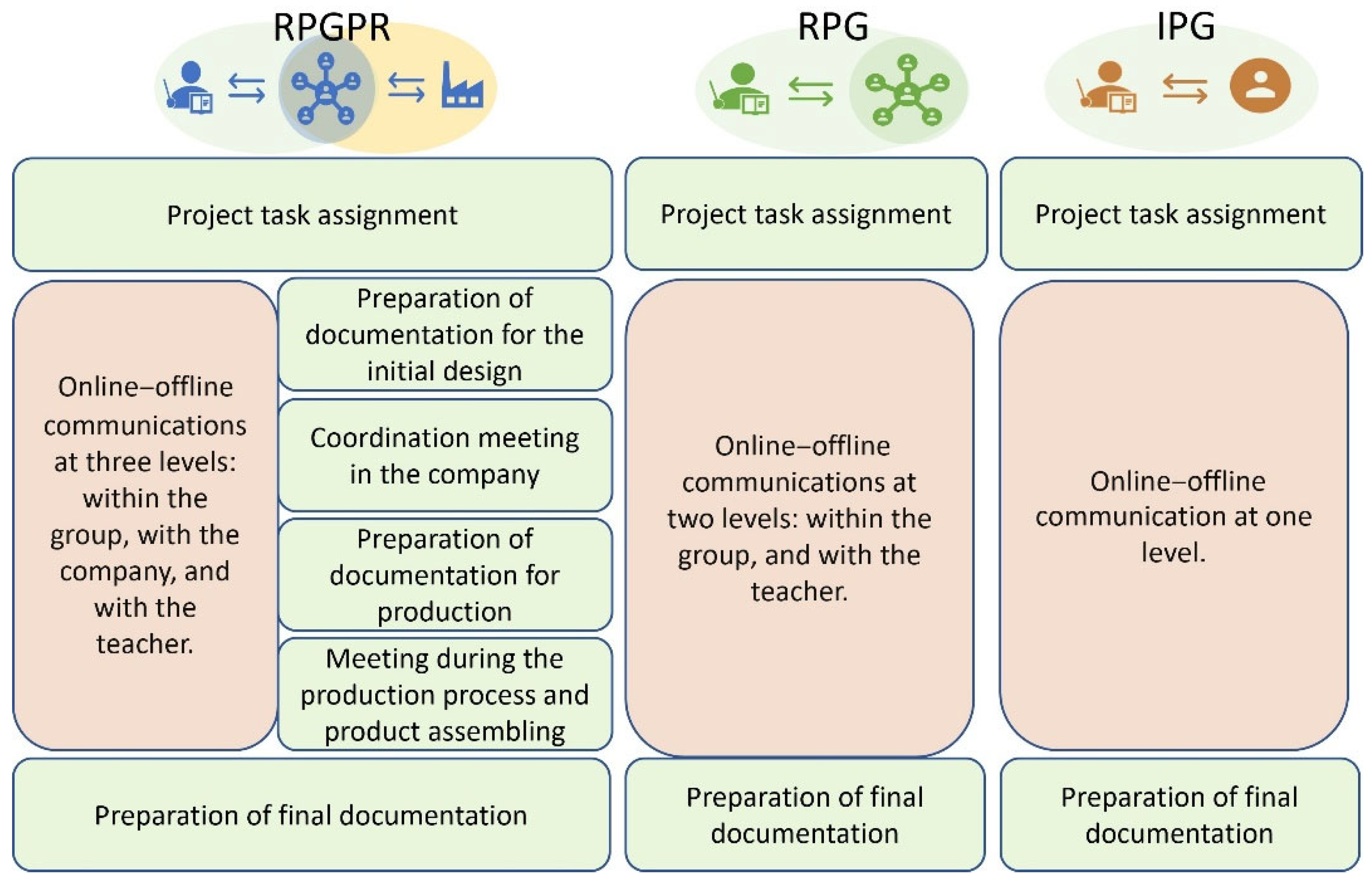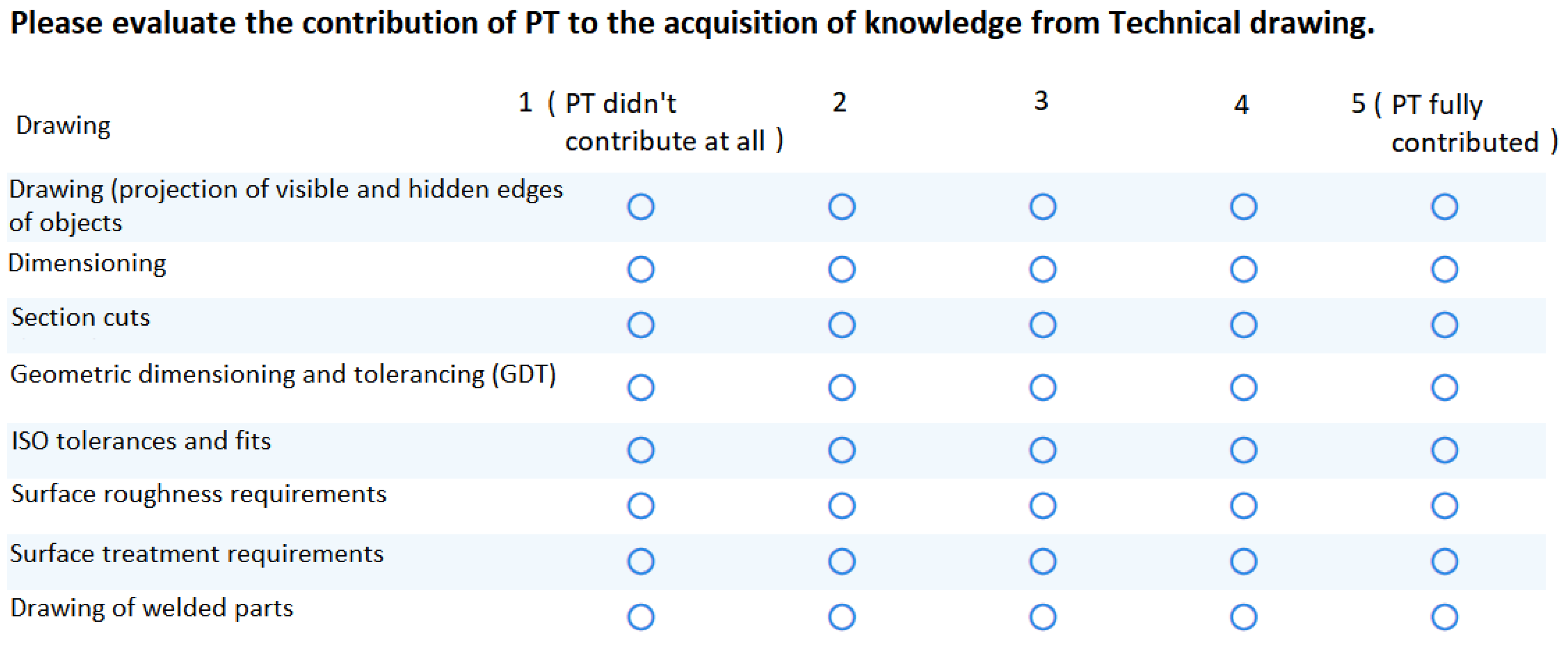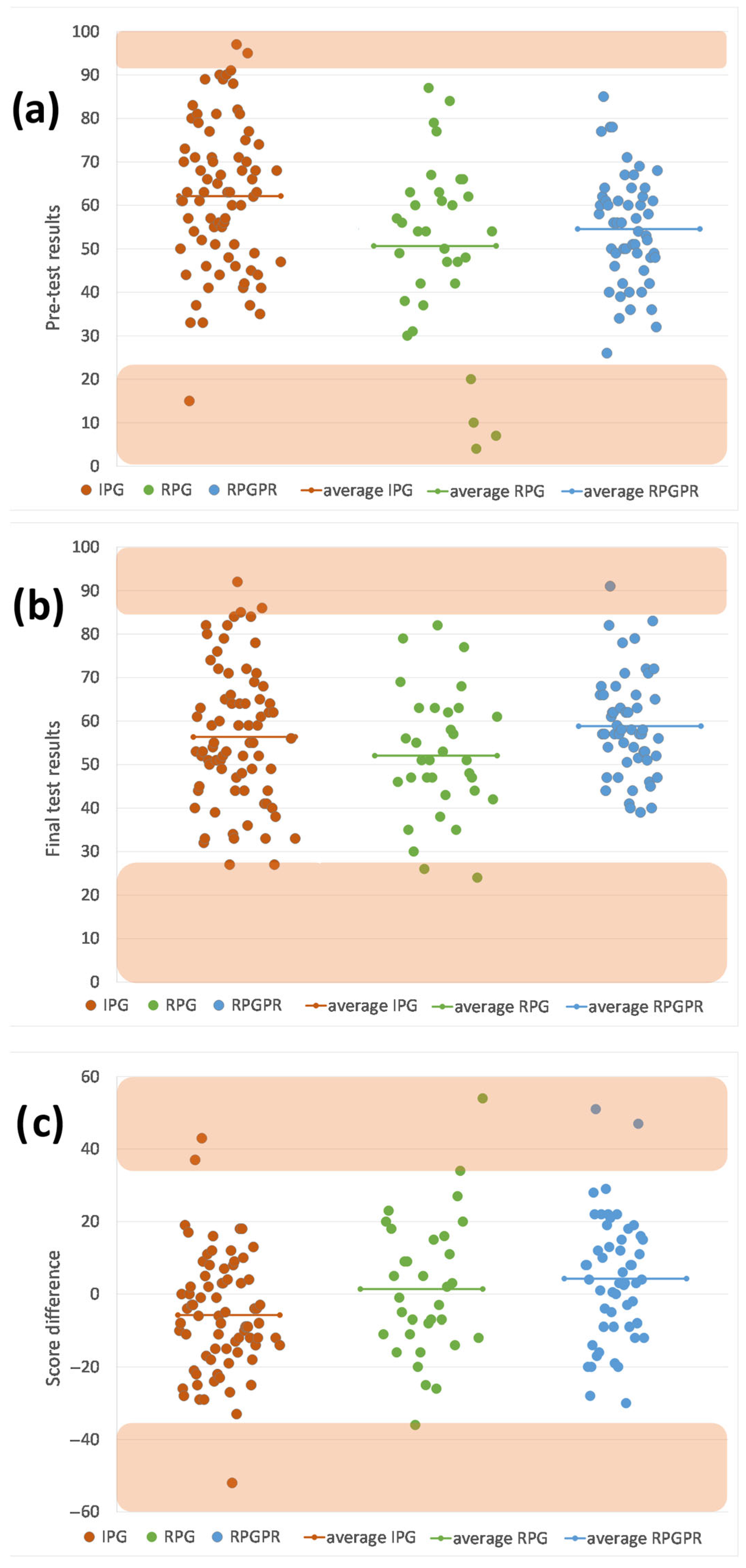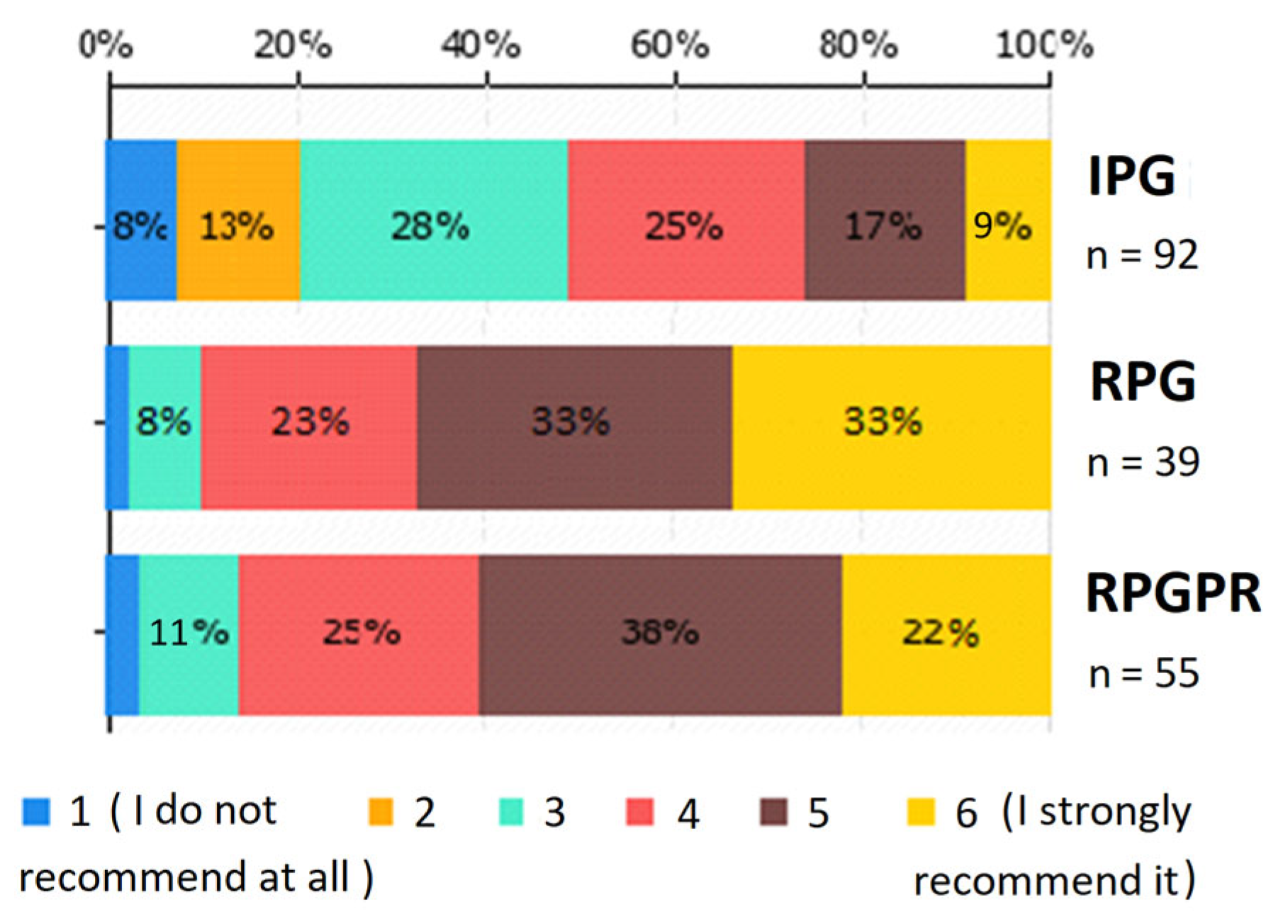From Paper to Product: Comparing the Effectiveness of Three Working Methods on Learning Outcomes and Social Interaction in a Technical Drawing Course
Abstract
1. Introduction
1.1. Literature Review
1.2. Research Questions
- Does the working methodology (individual vs. teamwork with or without real product manufacturing) affect students’ knowledge gain, as measured by the difference between pre- and post-test scores in a technical drawing course?
2. Methodology
2.1. Participants
2.2. The Course
2.3. Methodological Groups and Treatment
2.3.1. Individual Project Group (IPG)
2.3.2. Role-Play Project-Based Group (RPG)
2.3.3. Role-Play Project-Based Group with Project Realisation (RPGPR)
2.4. Pre- and Post-Test
2.5. Statistical Analysis
2.6. Survey
3. Results
3.1. Pre- and Post-Test Results
3.2. Survey Results
4. Discussion
5. Conclusions
Author Contributions
Funding
Institutional Review Board Statement
Informed Consent Statement
Data Availability Statement
Acknowledgments
Conflicts of Interest
Correction Statement
References
- Apedoe, X. S., Ellefson, M. R., & Schunn, C. D. (2012). Learning together while designing: Does group size make a difference? Journal of Science Education and Technology, 21(1), 83–94. [Google Scholar] [CrossRef]
- Ashel, H., Hamidah, I., Anwar, S., & Muslim, M. (2024). Research trends and opportunities of argumentation based learning for solving problems in physics learning: A bibliometric analysis. Jurnal Eksakta Pendidikan (JEP), 8, 99–114. [Google Scholar] [CrossRef]
- Barham, K. A. A., & Clarke, R. (2022). “When we see strange words”: Student-centered experiences using dictionary apps within and beyond the English language classroom in Palestine. Sage Open, 2022(10), 1–11. [Google Scholar] [CrossRef]
- Baronio, G., Motyl, B., & Paderno, D. (2016). Technical drawing learning tool-level 2: An interactive self-learning tool for teaching manufacturing dimensioning. Computer Applications in Engineering Education, 24(4), 519–528. [Google Scholar] [CrossRef]
- Bissett-Johnson, K., & Radcliffe, D. F. (2021). Engaging engineering students in socially responsible design using global projects. European Journal of Engineering Education, 46(1), 4–26. [Google Scholar] [CrossRef]
- Bonnema, G. M., Lutters-Weustink, I. F., & Van Houten, F. J. A. M. (2005, August 16–18). Introducing systems engineering to industrial design engineering students with hands-on experience. Proceedings—18th International Conference on Systems Engineering, IICSEng 2005 (pp. 408–413), Las Vegas, NV, USA. [Google Scholar] [CrossRef]
- Boyko, M., Turko, O., Dluhopolskyi, O., & Henseruk, H. (2021). The quality of training future teachers during the COVID-19 pandemic: A case from TNPU. Education Sciences, 11(11), 660. [Google Scholar] [CrossRef]
- Butler, D. (2012). Second Life machinima enhancing the learning of law: Lessons from successful endeavours. Australasian Journal of Educational Technology, 28(3), 383–399. [Google Scholar] [CrossRef]
- Chae, S. E., & Lee, M. S. (2019). Student-centered learning and higher-order thinking skills in engineering students. International Journal of Engineering Education, 35(2), 617–622. [Google Scholar]
- Clinciu, R. (2013). Graphical representation of solids—An important issue in teaching technical drawing. In O. D. DesPerrieres, S. Mazuru, & L. Slatineanu (Eds.), Innovative manufacturing engineering (Vol. 371, pp. 493–498). Trans Tech Publications, Ltd. [Google Scholar] [CrossRef]
- Crede, E., & Borrego, M. (2012). Learning in graduate engineering research groups of various sizes. Journal of Engineering Education, 101(3), 565–589. [Google Scholar] [CrossRef]
- Çakıroğlu, Ü., Saylan, E., Çevik, İ., Mollamehmetoğlu, M. Z., & Timuçin, E. (2022). Faculty adoption of online teaching during the COVID-19 pandemic: A lens of diffusion of innovation theory. Australasian Journal of Educational Technology, 38(3), 82–98. [Google Scholar] [CrossRef]
- Dagman, A., & Wärmefjord, K. (2022). An evidence-based study on teaching computer aided design in higher education during the COVID-19 pandemic. Education Sciences, 12(1), 29. [Google Scholar] [CrossRef]
- Da Silva, I. B., & Agostinho, O. L. (2018). A strategy for teaching and learning technical drawing. International Journal of Engineering Education, 34(6), 1939–1950. [Google Scholar]
- Demirhan, E., & Sahin, F. (2021). The effects of different kinds of hands-on modeling activities on the academic achievement, problem-solving skills, and scientific creativity of prospective science teachers. Research in Science Education, 51(Suppl. S2), 1015–1033. [Google Scholar] [CrossRef]
- Dewey, J. (1897). My pedagogical creed. In John Dewey on education: Selected writings. University of Chicago Press. [Google Scholar]
- Enache, I.-C., Valter, N., & Duca, M. (2018). The importance of blended learning for a technical drawing classes. In I. Roceanu, D. Beligan, L. Ciolan, & I. Stefan (Eds.), Elearning challenges and new horizons (Vol. 1, pp. 109–114). “CAROL I” National Defence University Publishing House. [Google Scholar] [CrossRef]
- Fakhry, M., Kamel, I., & Abdelaal, A. (2021). CAD using preference compared to hand drafting in architectural working drawings coursework. Ain Shams Engineering Journal, 12(3), 3331–3338. [Google Scholar] [CrossRef]
- Fernandes, F. A. O., Fuchter Júnior, N., Daleffe, A., Fritzen, D., & Alves De Sousa, R. J. (2020). Integrating CAD/CAE/CAM in engineering curricula: A project-based learning approach. Education Sciences, 10(5), 125. [Google Scholar] [CrossRef]
- Fisher, R. A. (1970). Statistical methods for research workers. In Breakthroughs in statistics: Methodology and distribution (pp. 66–70). Springer. [Google Scholar]
- Garnjost, P., & Lawter, L. (2019). Undergraduates’ satisfaction and perceptions of learning outcomes across teacher- and learner-focused pedagogies. International Journal of Management Education, 17(2), 267–275. [Google Scholar] [CrossRef]
- Gonzalez Campos, J. S., Sanchez-Navarro, J., & Arnedo-Moreno, J. (2019). An empirical study of the effect that a computer graphics course has on visual-spatial abilities. International Journal of Educational Technology in Higher Education, 16(1), 41. [Google Scholar] [CrossRef]
- Gutierrez-Berraondo, J., Iturbe-Zabalo, E., Arregi, N., & Guisasola, J. (2025). Influence on students’ learning in a problem- and project-based approach to implement STEM projects in engineering curriculum. Education Sciences, 15(5), 534. [Google Scholar] [CrossRef]
- Hiroi, Y., & Ito, A. (2023). A robotic system for remote teaching of technical drawing. Education Sciences, 13(4), 347. [Google Scholar] [CrossRef]
- Hornstein, E. A., & Eisenberger, N. I. (2022). Exploring the effect of loneliness on fear: Implications for the effect of COVID-19-induced social disconnection on anxiety. Behaviour Research and Therapy, 153, 104101. [Google Scholar] [CrossRef]
- Hortigüela-Alcala, D., Chiva-Bartoll, O., & Hernando-Garijo, A. (2022). “I feel lonely, I don’t understand you when you talk, and I find it hard to breathe”. Analysis of the emotional tensions of physical education students in the Spanish setting of COVID-19. Teaching and Teacher Education, 112, 103657. [Google Scholar] [CrossRef]
- Huck, S. W., & McLean, R. A. (1975). Using a repeated measures ANOVA to analyze the data from a pretest-posttest design: A potentially confusing task. Psychological Bulletin, 82(4), 511–518. [Google Scholar] [CrossRef]
- Huerta, O., Kus, A., Unver, E., Arslan, R., Dawood, M., Kofoglu, M., & Ivanov, V. (2019). A design-based approach to enhancing technical drawing skills in design and engineering education using VR and AR tools. In A. Kerren, C. Hurter, & J. Braz (Eds.), Proceedings of the 14th international joint conference on computer vision, imaging and computer graphics theory and applications—IVAPP (Vol. 3, pp. 306–313). SciTePress. [Google Scholar] [CrossRef]
- Ingham, A. G., Levinger, G., Graves, J., & Peckham, V. (1974). The Ringelmann effect: Studies of group size and group performance. Journal of Experimental Social Psychology, 10(4), 371–384. [Google Scholar] [CrossRef]
- Jiang, D., Dahl, B., & Du, X. (2022). A narrative inquiry into developing learner agency of engineering students in an intercultural PBL environment. European Journal of Engineering Education, 47(6), 1103–1121. [Google Scholar] [CrossRef]
- Jiang, D., Dahl, B., & Du, X. (2023). A systematic review of engineering students in intercultural teamwork: Characteristics, challenges, and coping strategies. Education Sciences, 13(6), 540. [Google Scholar] [CrossRef]
- Joyce, T., & Hopkins, C. (2014). ‘Part of the community?’ first year international students and their engineering teams. Engineering Education, 9(1), 18–32. [Google Scholar] [CrossRef]
- Kahu, E. R. (2013). Framing student engagement in higher education. Studies in Higher Education, 38(5), 758–773. [Google Scholar] [CrossRef]
- Kentel, A. S. (2022). Emergency remote teaching of technical drawing during the COVID-19 pandemic. International Journal of Mobile and Blended Learning, 14(1), 1–18. [Google Scholar] [CrossRef]
- Kim, J. H. (2017). Smartphone-mediated communication vs. face-to-face interaction: Two routes to social support and problematic use of smartphone. Computers in Human Behavior, 67, 282–291. [Google Scholar] [CrossRef]
- Kondo, A., Hayashi, H., & Toyoshi, T. (2023). Project-based learning of mechanical design utilizing CAE structural analyses. Education Sciences, 13(7), 687. [Google Scholar] [CrossRef]
- Luo, T., Arcaute, K., & Muljana, P. S. (2023). Integrating inquiry-based learning into engineering education: A case study. Innovations in Education and Teaching International, 60(6), 836–847. [Google Scholar] [CrossRef]
- Mahapatra, S. (2019). Smartphone addiction and associated consequences: Role of loneliness and self-regulation. Behaviour & Information Technology, 38(8), 833–844. [Google Scholar] [CrossRef]
- Martín, C., Segarra, I. M., Ibáñez, M. A., Mira, S., Fajardo, C., & González-Benito, M. E. (2021). Effectiveness of a hybrid project-based learning (H-PBL) approach for students’ knowledge gain and satisfaction in a plant tissue culture course. Education Sciences, 11(7), 335. [Google Scholar] [CrossRef]
- McKernon, S. L., Adderton, E. A., & Dawson, L. J. (2024). Using technology-supported approaches for the development of technical skills outside of the classroom. Education Sciences, 14(3), 329. [Google Scholar] [CrossRef]
- Melguizo-Garín, A., Ruiz-Rodríguez, I., Peláez-Fernández, M. A., Salas-Rodríguez, J., & Serrano-Ibáñez, E. R. (2022). Relationship between group work competencies and satisfaction with project-based learning among university students. Frontiers in Psychology, 13, 811864. [Google Scholar] [CrossRef] [PubMed]
- Mou, T. Y. (2023). Online learning in the time of the COVID-19 crisis: Implications for the self-regulated learning of university design students. Active Learning in Higher Education, 24(2), 185–205. [Google Scholar] [CrossRef]
- Mulryan-Kyne, C. (2010). Teaching large classes at college and university level: Challenges and opportunities. Teaching in Higher Education, 15(2), 175–185. [Google Scholar] [CrossRef]
- Pando Cerra, P., Gracia Rodriguez, J., Fernandez Alvarez, H., & Busto Parra, B. (2020). Combining multimedia and self-assessment CAD tools in an interactive web environment to learn engineering drawing. Interactive Learning Environments, 28(1), 81–94. [Google Scholar] [CrossRef]
- Pando Cerra, P., Suárez González, J. M., Busto Parra, B., Rodríguez Ortiz, D., & Álvarez Peñín, P. I. (2014). Can interactive web-based CAD tools improve the learning of engineering drawing? A case study. Journal of Science Education and Technology, 23(3), 398–411. [Google Scholar] [CrossRef]
- Parrish, C. W., Guffey, S. K., & Williams, D. S. (2023). The impact of team-based learning on students’ perceptions of classroom community. Active Learning in Higher Education, 24(2), 169–183. [Google Scholar] [CrossRef]
- Prianto, A., Qomariyah, U. N., & Firman. (2022). Does student involvement in practical learning strengthen deeper learning competencies? International Journal of Learning, Teaching and Educational Research, 21(2), 211–231. [Google Scholar] [CrossRef]
- Rashwan, O., Abu-Mahfouz, I., & Ismail, M. (2020). Student-centered assessment of the capstone design project course in mechanical engineering program. International Journal of Engineering Education, 36(3), 998–1008. [Google Scholar]
- Shana, Z., & Abulibdeh, E. S. (2020). Science practical work and its impact on students’ science achievement. Journal of Technology and Science Education, 10(2), 199–215. [Google Scholar] [CrossRef]
- Shen, Y., & Lu, W. (2021). Technology of animation in multimedia courseware of mechanical drawing. International Journal of Electrical Engineering Education, 61, 438–451. [Google Scholar] [CrossRef]
- Stefanou, C., Stolk, J. D., Prince, M., Chen, J. C., & Lord, S. M. (2013). Self-regulation and autonomy in problem- and project-based learning environments. Active Learning in Higher Education, 14(2), 109–122. [Google Scholar] [CrossRef]
- Stone, C., O’Shea, S., May, J., Delahunty, J., Partington, Z., McDougall, J., Lee, S. M., Fry, C., Bernard, R. M., Abrami, P. C., Borokhovski, E., Wade, C. A., Tamim, R. M., Surkes, M. A., Bethel, E. C., Coulson, F., Strategy, E., Committee, I., Dean, A., … McDougall, J. (2020). A framework for student engagement: Strategies for faculty teaching online. In Handbook of research on creating meaningful experiences in online courses (Vol. 12, Issue 1). IGI Global Scientific Publishing. [Google Scholar]
- Tomas, L., Evans, N. S., Doyle, T., & Skamp, K. (2019). Are first year students ready for a flipped classroom? A case for a flipped learning continuum. International Journal of Educational Technology in Higher Education, 16, 5. [Google Scholar] [CrossRef]
- Tsai, C.-Y., Shih, W.-L., Hsieh, F.-P., Chen, Y.-A., & Lin, C.-L. (2022). Applying the design-based learning model to foster undergraduates’ web design skills: The role of knowledge integration. International Journal of Educational Technology in Higher Education, 19(1), 4. [Google Scholar] [CrossRef]
- Vaillant, J., Hansen, C., Stolk, J., Johnston, S., Shina, S., & Willis, D. (2014, June 15–18). Hands on Made4Me: Hands-on machining, analysis, and design experiences for mechanical engineers. 2014 ASEE Annual Conference & Exposition, Indianapolis, Indiana. [Google Scholar] [CrossRef]
- Vaillant, J., Hansen, C., Stolk, J., Johnston, S., Shina, S., & Willis, D. (2015, June 14–17). Examining the integration and motivational impact of hands on Made4Me: Hands-on machining, analysis and design experiences for mechanical engineers. 2015 ASEE Annual Conference & Exposition (pp. 26.706.1–26.706.16), Seattle, WA, USA. [Google Scholar] [CrossRef][Green Version]
- Velázquez, J. S., Cavas, F., Fuentes, M. C., & García-Ros, R. (2023). Educational pathways, spatial skills, and academic achievement in graphic expression in first year of engineering. Education Sciences, 13(7), 756. [Google Scholar] [CrossRef]
- Venema, S., & Lodge, J. M. (2013). Capturing dynamic presentation: Using technology to enhance the chalk and the talk. Australasian Journal of Educational Technology, 29(1), 20–31. [Google Scholar] [CrossRef]
- Villa, V., Motyl, B., Paderno, D., & Baronio, G. (2018). TDEG based framework and tools for innovation in teaching technical drawing: The example of LaMoo project. Computer Applications in Engineering Education, 26(5), 1293–1305. [Google Scholar] [CrossRef]
- Vrellis, I., Avouris, N., & Mikropoulos, T. A. (2016). Learning outcome, presence and satisfaction from a science activity in Second Life. Australasian Journal of Educational Technology, 32(1), 59–77. [Google Scholar] [CrossRef]
- Willey, K., & Freeman, M. (2006). Improving teamwork and engagement: The case for self and peer assessment. Australasian Journal of Engineering Education. Available online: https://www.semanticscholar.org/paper/Improving-teamwork-and-engagement%3A-the-case-for-and-Willey-Freeman/adc58a96b0802a5c90c3c9313f82c060b3bbf617 (accessed on 10 August 2025).
- Wilson, A. B., Brown, K. M., Misch, J., Miller, C. H., Klein, B. A., Taylor, M. A., Goodwin, M., Boyle, E. K., Hoppe, C., & Lazarus, M. D. (2019). Breaking with tradition: A scoping meta-analysis analyzing the effects of student-centered learning and computer-aided instruction on student performance in anatomy. Anatomical Sciences Education, 12(1), 61–73. [Google Scholar] [CrossRef] [PubMed]
- Yakman, G. (2008, February 29). STEAM education: An overview of creating a model of intergrative education. Pupils Attitudes Towards Technology (PATT-19) Conference: Research on Technology, Ionnovation, Design & Engineering Teaching (Vol. 53, ), Salt Lake City, UT, USA. [Google Scholar]
- Zepke, N., & Leach, L. (2010). Improving student engagement: Ten proposals for action. Active Learning in Higher Education, 11(3), 167–177. [Google Scholar] [CrossRef]
- Zhang, L., Basham, J. D., Carter, R. A., Jr., & Zhang, J. (2021). Exploring factors associated with the implementation of student-centered instructional practices in US classrooms. Teaching and Teacher Education, 99. [Google Scholar] [CrossRef]
- Zhang, X., Zhang, B., & Zhang, F. (2023). Student-centered case-based teaching and online-offline case discussion in postgraduate courses of computer science. International Journal of Educational Technology in Higher Education, 20(1), 6. [Google Scholar] [CrossRef]
- Zhao, T., Deng, W., Yang, Y., Jin, Y., & Xu, F. (2025). Enhancing student satisfaction through open collaborative practical teaching reforms in public health education: A comparative study. Frontiers in Public Health, 13, 1546962. [Google Scholar] [CrossRef]
- Žavbi, R., & Tavčar, J. (2005). Preparing undergraduate students for work in virtual product development teams. Computers and Education, 44(4), 357–376. [Google Scholar] [CrossRef]














| Variables | Levels | Frequency |
|---|---|---|
| Gender | Female | 10 |
| Male | 196 | |
| Enrolment in 1st year | First time | 196 |
| Second time | 10 | |
| Lecturer | Teaching assistant 1 | 108 |
| Teaching assistant 2 | 56 | |
| Teaching assistant 3 | 42 | |
| Language | Native language | 194 |
| Foreign language | 12 | |
| Methodological group | IPG | 98 |
| RPG | 43 | |
| RPGPR | 64 | |
| Pre-test participation | Yes | 176 |
| No | 30 | |
| Both tests participation | Yes | 162 |
| No | 54 | |
| Used in the analysis | Within 2 standard deviations of the average | 144 |
| Outliers | 18 |
| Principles | Teaching and Learning Activities |
|---|---|
| Identify and define context | Visual inspection of the object, identification of characteristic features, decision on manufacturing and assembly processes |
| Basics for projecting objects | Selection of drawing format and framing, decision on multi-view projection layout, selecting the orientation and the main view, determining the auxiliary view requirements, drafting the individual views according to standards |
| Section cuts | Identification of the section requirements, selecting the section method according to standards, implementation of the section symbols in the drawing |
| Standard features | Identification of standard features (threads, grooves, countersunk holes, etc.), standard simplifications for display, retrieving data, presentation on drawings |
| Dimensioning | Following the basic principles of dimensioning according to standards, adjusting and positioning the dimensions according to the selected manufacturing process |
| Dimensional tolerances and fits | Identification of the features that require dimensional tolerances, selecting fits according to functional requirements, calculation of tolerance limits and fit clearances according to standards, implementation of the dimensional tolerance information on the drawing |
| Surface quality | Identification of the features that require surface quality information, standard symbols for surface quality, achievable surface qualities of different manufacturing processes, relation between surface quality and dimensional tolerance |
| Geometrical dimensioning and tolerancing (GDT) | Purpose and basic principles of GDT, relations between features, types of GDT, datum features, datum dimensions, material conditions, standard GDT symbols and their placement on the drawing |
| Other symbolic information | Standard symbolic information associated with welding, casting, and forging, and its relation to the manufacturing process, producing special drawings containing this information according to standards |
| Student No. | Assembly Roles (Tasks Within the Group) Corresponding to Figure 5a |
|---|---|
| 1 | Pulley, circlip, and shaft dowel key |
| 2 | Selection of bearings along with tolerances and surface quality requirements for bearing settings |
| 3 | Pulley, circlip, and shaft dowel key |
| 4 | Assembly drawing |
| 5 | Sub-assembly drawing of the housing |
| 6 | Selection of wheels and definition of wheel seatings |
| 7 | Bearing housing cover on the left side |
| 8 | Assembly drawing |
| 9 | Production drawing of the shaft |
| 10 | Selection of wheels and definition of wheel seatings |
| 11 | Bearing housing cover on the right side |
| 12 | Production drawing of the shaft |
| N | Mean | Std. Deviation | Std. Error | 95% Confidence Interval for Mean | Minimum | Maximum | Between- Component Variance | |||
|---|---|---|---|---|---|---|---|---|---|---|
| Lower Bound | Upper Bound | |||||||||
| RPG | 27 | −1.556 | 13.776 | 2.651 | −7.005 | 3.894 | −26.0 | 23.0 | ||
| RPGPR | 51 | 2.510 | 14.902 | 2.086 | −1.682 | 6.701 | −30.0 | 29.0 | ||
| IPG | 66 | −6.409 | 13.404 | 1.650 | −9.704 | −3.144 | −33.0 | 19.0 | ||
| Total | 143 | −2.340 | 14.490 | 1.207 | −4.727 | −0.047 | −33.0 | 29.0 | ||
| Model | Fixed Effects | 14.021 | 1.168 | −4.650 | −0.030 | |||||
| Random Effects | 3.033 | −15.391 | 10.711 | 21.139 | ||||||
| Sum of Squares | df | Mean Square | F | Sig. | |
|---|---|---|---|---|---|
| Between Groups | 2308.960 | 2 | 1154.480 | 5.873 | 0.004 |
| Within Groups | 27,718.866 | 141 | 196.588 | ||
| Total | 30,027.826 | 143 |
| (I) Methodology | (J) Methodology | Mean Difference (I-J) | Std. Error | Sig. | 95% Confidence Interval | |
|---|---|---|---|---|---|---|
| Lower Bound | Upper Bound | |||||
| RPG | RPGPR | −4.065 | 3.337 | 0.444 | −11.970 | 3.839 |
| IPG | 4.853 | 3.203 | 0.287 | −2.734 | 12.441 | |
| RPGPR | RPG | 4.065 | 3.337 | 0.444 | −3.839 | 11.970 |
| IPG | 8.918 * | 2.614 | 0.002 | 2.727 | 15.111 | |
| IPG | RPG | −4.853 | 3.203 | 0.287 | −12.441 | 2.734 |
| RPGPR | −8.918 * | 2.614 | 0.002 | −15.111 | −2.727 | |
Disclaimer/Publisher’s Note: The statements, opinions and data contained in all publications are solely those of the individual author(s) and contributor(s) and not of MDPI and/or the editor(s). MDPI and/or the editor(s) disclaim responsibility for any injury to people or property resulting from any ideas, methods, instructions or products referred to in the content. |
© 2025 by the authors. Licensee MDPI, Basel, Switzerland. This article is an open access article distributed under the terms and conditions of the Creative Commons Attribution (CC BY) license (https://creativecommons.org/licenses/by/4.0/).
Share and Cite
Trajkovski, J.; Ambrož, M.; Kunc, R. From Paper to Product: Comparing the Effectiveness of Three Working Methods on Learning Outcomes and Social Interaction in a Technical Drawing Course. Educ. Sci. 2025, 15, 1121. https://doi.org/10.3390/educsci15091121
Trajkovski J, Ambrož M, Kunc R. From Paper to Product: Comparing the Effectiveness of Three Working Methods on Learning Outcomes and Social Interaction in a Technical Drawing Course. Education Sciences. 2025; 15(9):1121. https://doi.org/10.3390/educsci15091121
Chicago/Turabian StyleTrajkovski, Jovan, Miha Ambrož, and Robert Kunc. 2025. "From Paper to Product: Comparing the Effectiveness of Three Working Methods on Learning Outcomes and Social Interaction in a Technical Drawing Course" Education Sciences 15, no. 9: 1121. https://doi.org/10.3390/educsci15091121
APA StyleTrajkovski, J., Ambrož, M., & Kunc, R. (2025). From Paper to Product: Comparing the Effectiveness of Three Working Methods on Learning Outcomes and Social Interaction in a Technical Drawing Course. Education Sciences, 15(9), 1121. https://doi.org/10.3390/educsci15091121








